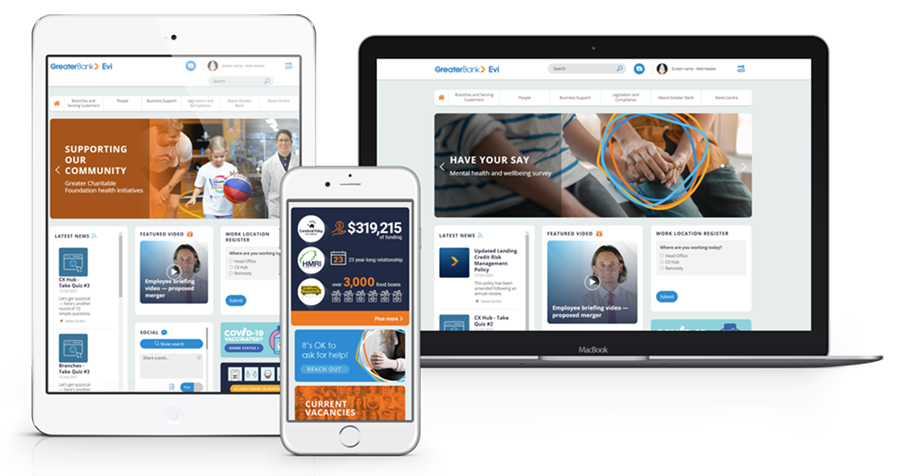In the fast-paced retail industry, operational efficiency and employee engagement have become paramount for success.
Here's where digital workplace tools like a robust intranet can play a transformative role.
From enhancing employee training to boosting sales and ensuring security compliance, a digital workplace can help create a more streamlined and collaborative retail environment.
Enhancing Employee Training and Onboarding
When we talk about a digital workplace's impact on training and onboarding, we're referring to features such as integrated Learning Management Systems (LMS). This functionality allows organisations to create, track, and manage digital training programs within their intranet.
An LMS can provide interactive learning modules, video training content, and quizzes to make learning more engaging for new hires. It can also help to track their progress and provide feedback, encouraging a culture of continuous learning and improvement.
Integrated with a knowledge base, it can centralise and streamline the distribution of training materials, reducing costs related to printing and distribution. It also ensures consistency in training, as all employees have access to the same resources.
Tip: Make the most of your LMS by creating interactive and engaging training content that caters to different learning styles. This could include video content, quizzes, infographics, and more. For instance, you can develop product knowledge courses that incorporate multimedia elements and interactive scenarios to engage your employees. New hires can access these resources at their own pace, ensuring a consistent and comprehensive onboarding experience.
Boosting Retail Sales
Digital workplace tools can help boost retail sales in many ways. For instance, team workspaces and Q&A forums can foster conversations about products and best practices, leading to improved product knowledge among staff.
Quick messaging social tools can help staff seek immediate help for customer queries, enhancing customer service. Similarly, the use of announcement tools for communicating updates, promotions, and sales targets can keep the team aligned and motivated to meet goals.
Greater Bank, for example, use their intranet to foster engagement among staff. Using social collaboration tools, employees can engage with each other, share knowledge and post questions to colleagues. Frontline employees use social to reach out to other branches for assistance, for example, if they are short on supplies (pop it in the internal mail bag) or questions about processes. With this level of collaboration and transparency, matters can be raised and addressed quickly either amongst frontline employees or via head office support staff who might be tagged in a post (and receive an email notification) by other users who think a particular person may be able to help.

Tip: Encourage your team to use team workspaces and community spaces instead of email for communication about products, sales, and customer queries. Not only will it keep everyone informed, but it will also create a knowledge base that can be referred to in the future.
Enhancing Internal Communication
There are several ways you can use digital workplace tools to enhance internal communication.
You can use blogs to share long-form updates and thought leadership pieces. Social posts are excellent for more interactive, real-time communication.
Personalised news feeds can be set up based on the department or store location, ensuring employees see the most relevant information first. This significantly improves the relevance and consumption of information, thereby increasing engagement.
Additionally, the use of a digital workplace can greatly improve transparency within an organisation. Through features like online workspaces, everyone can have a clear view of ongoing projects, updates, and responsibilities, leading to a more trusting and cohesive team.
Improving Security and Compliance
When it comes to security and compliance in the retail sector, an intranet in particular provides several functionalities that help organisations stay ahead. Secure data storage, for instance, ensures that sensitive data such as employee records or customer information are stored in a safe environment.
Moreover, the access control functionality of an intranet can be instrumental in maintaining data security. By providing different access levels, organisations can control who can view or edit specific pieces of content. This feature is particularly important for large retail organisations where information needs to be shared selectively.
Intranets also offer comprehensive audit trails, a vital feature for compliance. This means that all actions taken within the intranet are logged and can be reviewed when needed. Such an audit trail can help in tracing the source of information leaks or potential security breaches.
Tip: Regularly review the access rights of your intranet users to ensure they are aligned with their roles and responsibilities. Also, make use of the audit trail to monitor user activity and to track any potential security issues. For instance, sensitive documents containing customer information can be stored securely within the intranet, limiting access only to authorized personnel. Access controls can be customized based on roles and responsibilities, ensuring that employees have appropriate levels of access. Audit trails track user activity, allowing you to monitor and identify any potential security breaches.
Uniting a Dispersed Workforce
A digital workplace is equipped with features that help unite dispersed retail teams. An intranet can serve as a central repository for important documents such as inventory lists, brand assets, policies, and procedures. This ensures that all team members, irrespective of their location, have access to the same, up-to-date information.
Online knowledge bases allows organisations to store and share critical information. This could include troubleshooting guides, how-to articles, or even details about products or procedures.
Additionally, mobile accessibility ensures that this information can be accessed anytime, anywhere. This is especially beneficial for retail organisations where frontline employees need a platform that caters to the fact that they access information on their mobile phones.
Beyond serving as a digital resource hub, an intranet can help foster a sense of community with frontline employees. Features like online communities, social tools, and integration with third-party tools like Microsoft Teams can create a virtual space for team members to connect, collaborate, and engage with each other.
Strengthening Partner and Supplier Relationships
With a dedicated portal for suppliers and partners, organisations can streamline all communication and transactions in one place. The portal can serve as a shared workspace where contracts can be reviewed, orders placed, delivery schedules confirmed, and invoices processed. This eliminates the need for endless email threads, reducing the chances of miscommunication.
Moreover, by providing real-time access to important data such as inventory levels, product details, and sales forecasts, you enable suppliers and partners to react promptly to your needs. This leads to more efficient operations, better planning, and ultimately improved service to customers.
Another key feature of a supplier and partner portal is the ability to provide tailored access to different users. Just like with internal access controls, this means that each supplier or partner only sees the information relevant to them. This protects your sensitive data while ensuring smooth business operations.
For instance, you can establish a portal where suppliers can access and update product catalogs, view purchase orders, and provide delivery updates. This streamlines communication, reduces manual paperwork, and fosters strong relationships with your suppliers and partners
Conclusion
A digital workplace is not just a nice-to-have but a must-have in the modern, post-covid retail landscape.
In particular, by implementing an intranet, retail organisations can unlock numerous benefits - from enhanced training to improved sales and security. It's time to leverage these digital tools and propel your retail operation to new heights.
